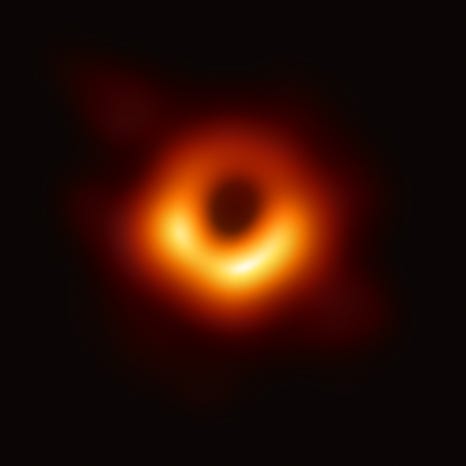# Remarkable Insights into the Milky Way's Nearby Black Hole
Written on
Chapter 1: Understanding Supermassive Black Holes
Most galaxies harbor a supermassive black hole (SMBH) at their core, and the Milky Way is no exception. At the heart of our galaxy lies Sagittarius A* (Sgr A*), a supermassive black hole located approximately 26,000 light years from Earth, boasting a mass four million times that of the Sun. However, dense clouds of dust obstruct our view of this cosmic giant when using visible light. Recent microwave studies emanating from the galactic center have unveiled a cool gas ring encircling this supermassive black hole.
The Atacama Large Millimeter/submillimeter Array (ALMA), perched in the Andes Mountains of Chile, was employed to investigate this colossal entity. Astronomers at ALMA discovered a hidden, cool disk of gas nestled within the luminous, heated sphere surrounding the black hole.

An artistic representation illustrating the inner ring of the supermassive black hole at the core of the Milky Way. Image credit: NRAO/AUI/NSF; S. Dagnello
Elena Murchikova, an astrophysicist at the Institute for Advanced Study, remarked, “We are the first to capture an image of this elusive disk and examine its rotation. We are also investigating accretion processes onto the black hole. This is significant because it is our nearest supermassive black hole, yet we still lack a comprehensive understanding of its accretion dynamics. We hope that these new ALMA observations will help the black hole reveal some of its secrets.”

The ALMA image depicting the cool inner disk surrounding our local supermassive black hole. Image credit: ALMA (ESO/NAOJ/NRAO), E.M. Murchikova; NRAO/AUI/NSF, S. Dagnello
The Hot and Cold Dynamics of the Milky Way
The area surrounding Sgr A* teems with stars, immersed in clouds of interstellar gas and dust. The newly identified disk, containing one-tenth the mass of Jupiter, orbits a mere 3.5 light days from the event horizon, roughly 1,000 times the distance from Earth to the Sun. While this may seem distant, materials within the ring are perilously close to disappearing beyond the event horizon, where not even light can escape the gravitational pull.
Dialogue from a Cinematic Perspective:
Hans Reinhardt: Tonight, my friends, we stand on the brink of a feat unparalleled in space exploration. If the data on my returning probe ship matches my computerized calculations, I will travel where no man has dared to go.
Alex Durant: Into the black hole?
Reinhardt: In… through… and beyond.
Harry Booth: Why, that’s crazy! Impossible!
Reinhardt: The word “impossible”, Mr. Booth, is only found in a dictionary of fools.
— The Black Hole (1979), Walt Disney Productions
Although different regions within this disk experience varying temperatures, it remains significantly cooler than the surrounding gas and dust sphere. The disk maintains a temperature around 10,000 degrees Celsius (18,000 degrees Fahrenheit), while the surrounding gas reaches temperatures ten times higher, making it nearly two-thirds as hot as the Sun's core. The luminous sphere does not rotate uniformly around Sgr A*, but it shines brightly in X-rays, marking it as an easily observable target for astronomers.
The Enigmatic Nature of Black Holes
At their core, black holes are regions where mass is so concentrated that not even light can escape. Once a black hole forms, it can increase its mass by consuming gas, dust, and larger materials that venture too close.
NASA explains, “As Sgr A*’s intense gravity draws in clumps of material, tidal forces stretch these clumps as they approach the black hole. Additionally, Sgr A* affects its environment through occasional outbursts that expel material away from the supermassive entity.” Astronomers utilizing ALMA have successfully tracked the movement of gas in a spiraling descent toward our galactic black hole.
While the SMBH at the Milky Way's center remains relatively calm, the surrounding radiation is so intense that it causes hydrogen atoms in the vicinity to repeatedly lose and regain electrons. This interaction leads to the emission of microwave radiation, with a wavelength of approximately 1 mm (1/25 inch), which traverses the space between the galactic center and Earth before detection by ALMA.

The inaugural image of a black hole showcased the SMBH at the center of the M87 galaxy. Image credit: Event Horizon Telescope
New Discoveries in Accretion Disks
These findings may aid astronomers in enhancing their understanding of accretion disks, the spiral formations of matter often depicted in science fiction.
The Milky Way Galaxy is on a collision course with both the Large Magellanic Cloud and our massive neighbor, the Andromeda Galaxy. In April 2019, an international team of astronomers unveiled the first-ever image of a black hole, focusing on the supermassive black hole within the M87 galaxy. This recent study provides a closer examination of the supermassive black hole that resides in our backyard.